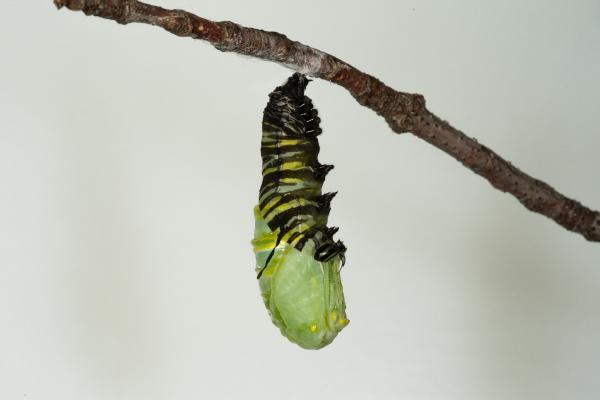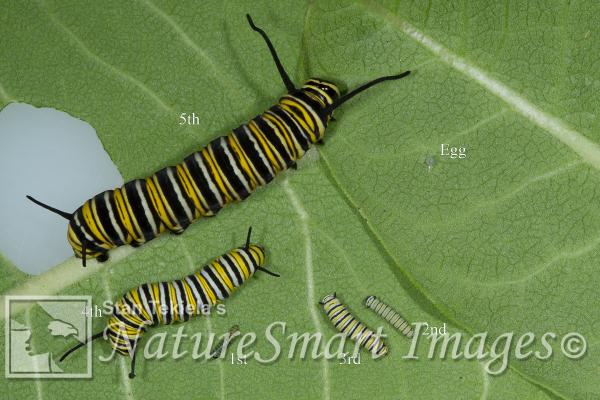View all of the titles in the
NatureSmart Bookstore


by Stan Tekiela
© NatureSmart
September 26, 2016
There are so many amazing and marvelous aspects in nature. Take the Monarch Butterfly (Danaus plexippus) for example, this may be the most familiar and recognized butterfly in North America yet I am not sure it's understood just how special or amazing this winged creature really is. It's a good example of a species that is right under our noses but we don't seem to appreciate it.
Unfortunately, due to unprecedented drop in population over the past 10 years, it is now being considered by the U.S. Fish and Wildlife Service as a candidate for the endangered species list.
Recently I have been photographing all of the life stages of the Monarch Butterfly in my studio, and I must tell you that I am so impressed with this tiny creature. Even after 30 years of studying wildlife and traveling to the far corners of the world to study and photograph amazing creatures, I am totally amazed by the tiny Monarch Butterfly right in front of me.
Let's start with the egg. After mating a female can lay anywhere from 300 to 1,300 eggs. Each egg is about 1/1000 the mass of the female, which means she will lay equal to her own body mass in eggs in just a couple days time. Each egg is laid on the underside of a milkweed plant, which is the preferred food plant for the developing caterpillar. It takes only 3-8 days to hatch and a tiny caterpillar crawls out.
The caterpillar, also called a larvae, goes through five growth stages, each time molting to become larger. Each stage is called an instar. At each of the five stages there are slight visible changes. I had a chance to collect all five stages together at one time and take a picture showing each unique caterpillar life stage and the egg.
What comes next is hard to believe. I have seen it many times and I am still owe-struck each time I witness it. When full size, the caterpillar finds a suitable place to change from a caterpillar into a pupa. The caterpillar will spin a silken pad on a horizontal substrate. It then hangs from the pad by a pair of strong hind legs. The body of the caterpillar hangs down in a J shape. This is where the magic happens. Inside the caterpillars body, all of the cells transform. The back of the hanging caterpillar splits open and it sheds its caterpillar skin leaving behind a green exoskeleton called a chrysalis, containing all of the transforming cells that soon will make a completely new animal inside. The adult butterfly.
While photographing this stage, one of the caterpillars did exactly this and I was able to capture the entire process with my camera. Taking just a couple minutes my mouth hung open as the wriggling caterpillar slipped out of its skin and left behind the green chrysalis. This is the very moment that is so amazing. It transforms from one kind of creature into a completely different kind. Real science fiction stuff.
After about 10-12 days in the hanging green chrysalis the skin becomes translucent and you can see the adult butterfly inside. Once again the casing splits open and a fully formed adult butterfly crawls out and hangs upside down while fluids are pumped into the wings, until they expand and harden. Soon after the butterfly will take flight and beginning feeding on the nectar of flowers. At this time of year these adult Monarchs will migrate south to Mexico to spend and winter. Once again performing another amazing feat of nature.
Last winter I was thrilled to visit one of the wintering sites in southern California to see thousands of adult monarchs spending the winter clinging to the leaves and branches of trees waiting for their time to migrate northward. You can go to www.naturesmart.com and search for this story and learn more about the most amazing Monarch Butterfly. Until next time...
Stan Tekiela is an author / naturalist and wildlife photographer who travels the US to study and photograph wildlife. He can be followed on www.facebook.com and twitter.com. He can be contacted via his web page at www.naturesmart.com.
The nationally syndicated NatureSmart Column appears in over 25 cities spanning 7 states: Minnesota, Wisconsin, Michigan, Illinois, Ohio, New York and Pennsylvania. It is a bi-weekly column circulated to over 750,000 readers.
Wolves
Just the day before, a pack of wolves known as the Wapiti, had found a large bull bison that was weak and injured. Based on its size, this big boy was near the end of its lifespan and the winter weather was taking its toll. For a full day the wolves tried to approach the bison but when the bison...
Moose
It was one of those dark and cloudy winter days in Yellowstone National Park where the clouds are so heavy and low, you feel like you can reach up and touch the cloudy sky. A light wind helped to blow the falling snow with occasional gusts of wind causing swirls of fluffy white snow...
American Badger
It’s funny, I believe the average person knows more about the Honey Badger (Mellivora capensis), a critter of Africa and Southwest Asia than they do about the badger in our own backyard, the American Badger (Taxidea taxus). Social media has a lot to do with the Honey Badger phenomena and...
Backyard Bird Feeding
Winter bird feeding is one of the most common / popular hobbies in America. It is estimated that nearly 60 million Americans feed birds in their yards in winter or summer. That is about 40 percent of all American’s make backyard bird feeding part of their everyday activities. It’s...
View all of the titles in the
NatureSmart Bookstore
Check out Stan's latest photos at
NatureSmart Wildlife Images
Take a tour with Stan.
» More Info
Hear Stan on radio stations all across the Midwest.
» More Info

When he's out in the field, Stan relies on his Vortex Razor binoculars and Vortex Razor spotting scope to help find the subjects for his award winning wildlife photography.

For thirty years, professional wildlife photographer Stan Tekiela has counted on Hunt's Photo and Video to provide him with professional photography equipment.
From tripods to camera bodies and lenses, Hunt's has been Stan's place for everything that he needs. Personal service and prompt shipping means Stan can count on Hunt's to support his professional wildlife photography career.


Professional Wildlife Photographer Stan Tekiela always uses Feeder Fresh in his seed feeders to help keep the feeders and food dry, clean and mold free.
He also uses Feeder Fresh Nectar Defender in all of his hummingbird feeders. It safely keeps nectar fresh longer.